Manuel Antonio – Costa Rica’s Most Popular Park
This is the first true post on the Adventures Abroad’s 2020 tour of Central America led by guide extraordinaire Victor Romagnoli. In my last post I extolled some of the virtues of the Costa Rican capital, San Jose before joining up with the rest of the group who began this tour with Victor in Panama a week earlier. After spending a second night at the excellent Gran Hotel Costa Rica we are now boarding the bus and heading for Manuel Antonio National Park just outside the small town of Quepos on the Pacific Ocean. Although Alison and I have been to Costa Rica before, we’ve never been to the Pacific side of the country which is where most of the seaside resorts and attractions are located. It’s about a five hour drive even taking what is a newly opened portion of highway to shorten the distance to this popular part of the country. However, Victor is a great raconteur and between his history and biology lessens combined with some great stories from past trips the time to our first stop passes quickly.
The highway first reaches the Pacific Ocean at the small town of Tárcoles where a river of the same name drains into the sea. We get off the bus to observe this tranquil looking sight from the bridge that crosses the river here.
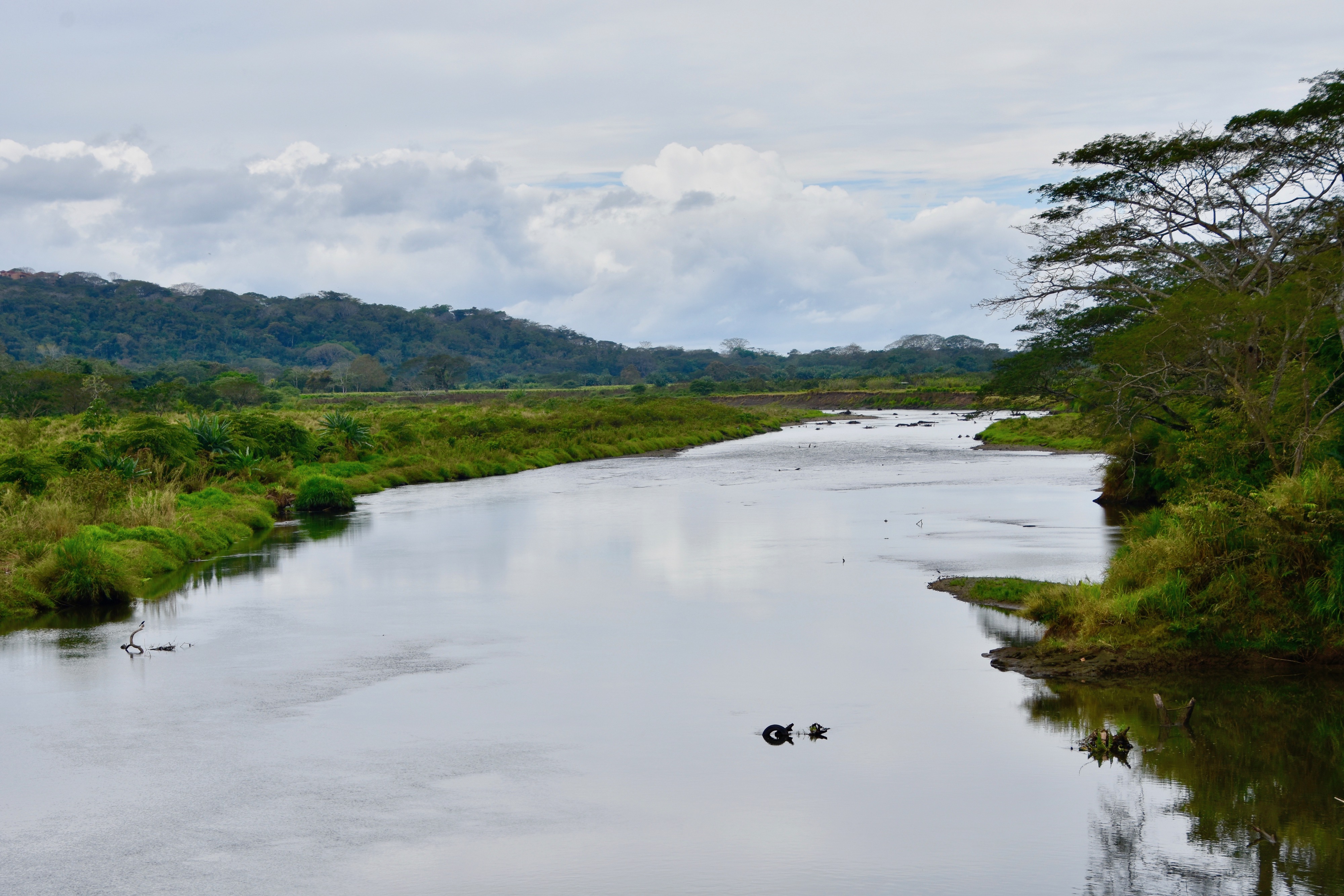
And then I look down and see this. Altogether I count 17 or 18 decent size crocodiles or cocodrilos as the Ticos say which just rolls off the tongue, but in either language it means the Tárcoles is literally ‘croc infested’.
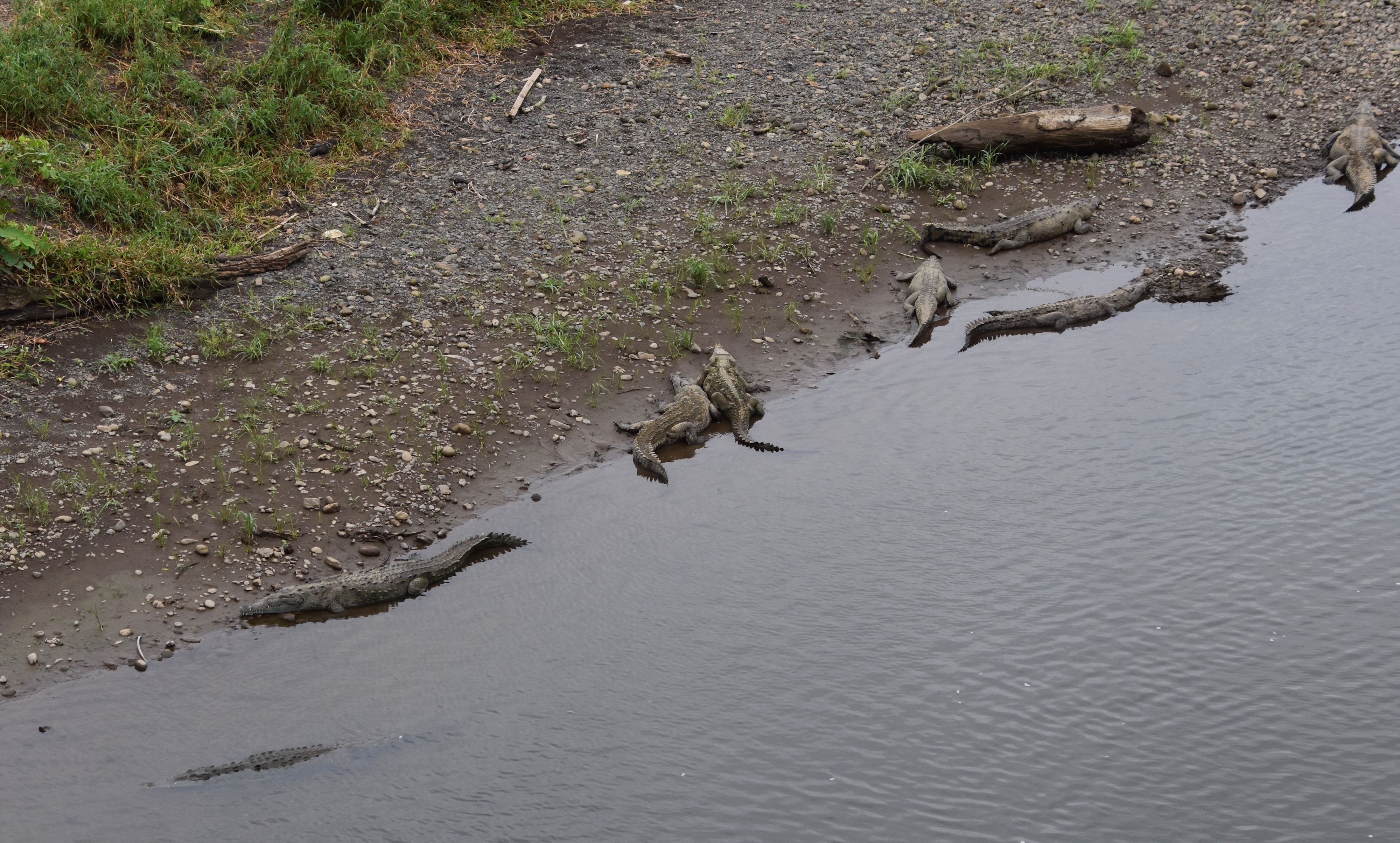
Looking down from the other bank directly below is this enormous specimen who would easily run fifteen feet. I’ve seen big crocs in Africa, but had no idea they grew this big in the Americas. A little research finds that crocs in the Tárcoles have been known to reach a length of twenty feet. One of the reasons apparently is that because they are a tourist attraction these ones are fed regularly to keep them reliably near the bridge. Even if they are well fed and maybe not up for a human snack I would not want to get any closer to this guy than this.
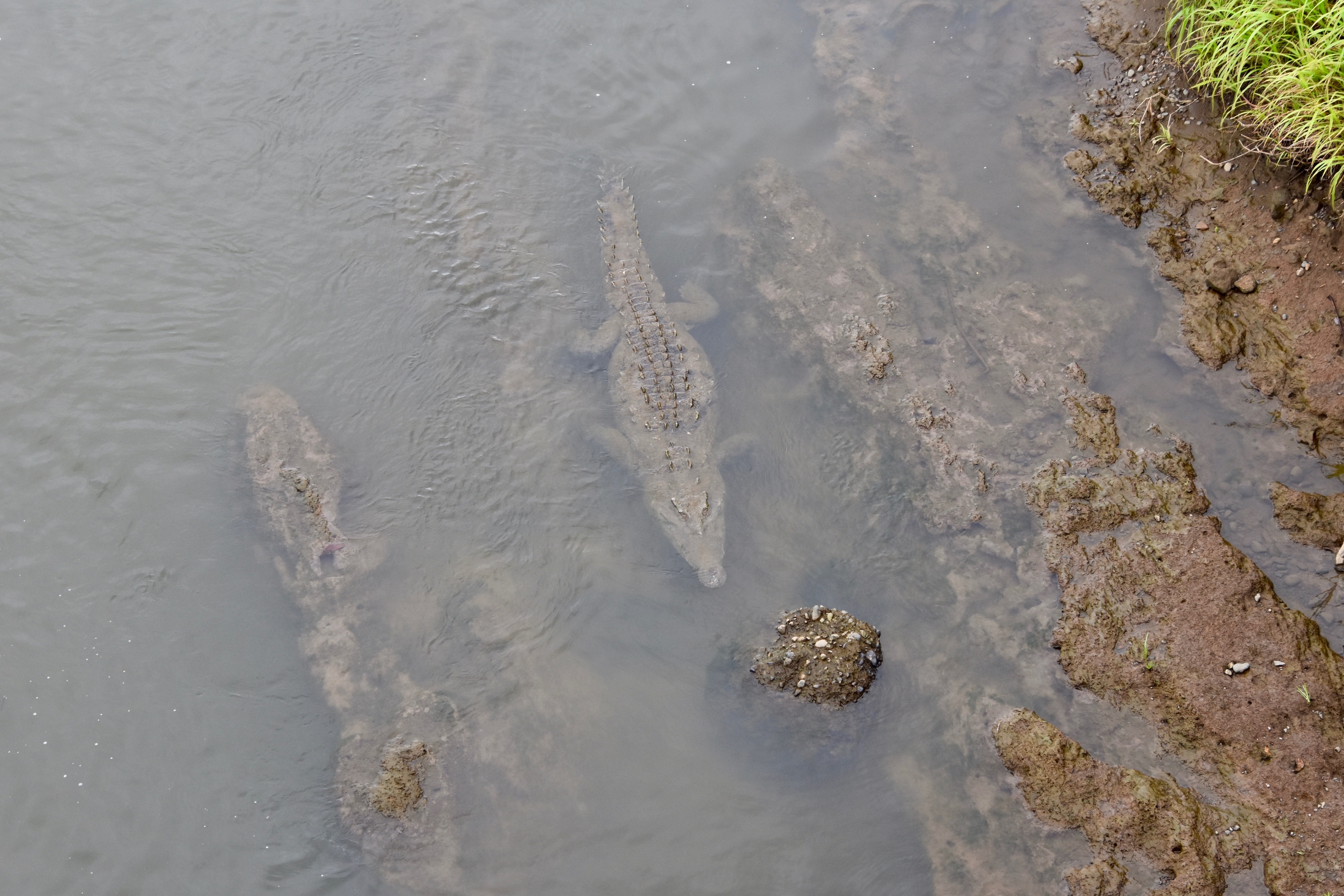
Not far past Tárcoles is the town of Jaco, very popular with Canadian tourists, especially Quebecois, but we just breeze by. Then I start seeing the unmistakable signs of palm oil plantations which causes me to go on this mini rant. Palm oil is by far the highest yielding source of vegetable oil on the planet and is found in over 50% of all consumer products. That includes bread, ice cream, soap and the original product from chemistry hell – margarine. Oh, and it’s also a big component of biodiesel. As a product, it definitely has it’s uses, and it’s not as unhealthy for consumers as was once believed, in fact it might actually be beneficial. But, it is unquestionably bad for the planet. Since the dawn of the 21st century an area of rainforest the size of New Zealand has been cleared to plant palm oil in Indonesia and Malaysia. Goodbye orangutans and thousands of other species. The WWF does not advocate abandoning the use of palm oil, but finding better ways to grow it sustainably.
Now here’s what really ticks me off about palm oil. It’s in every bloody vegan concoction going. Vegans, like my daughter, think they are saving the environment by following a vegan diet. Well I’m sorry, you’re not and you are in fact contributing to world wide deforestation. It’s sad to see it taking off in areas of Costa Rica that were previously dedicated to fruit growing. The town of Parrita is dedicated almost solely to palm oil growing and refining. After jumping out of the United Fruit Company fire it has now landed in the palm oil pot.
Okay, back to being a brainless tourist. We stop for lunch at the small town of Quepos which is the entryway to Manual Antonio. As a town it’s pretty ordinary, but Alison and I have lunch at a stall in the local market which is tasty, filling and very inexpensive. A walk around town takes us to a view of Quepos beach which looks lovely, but has few people on it.
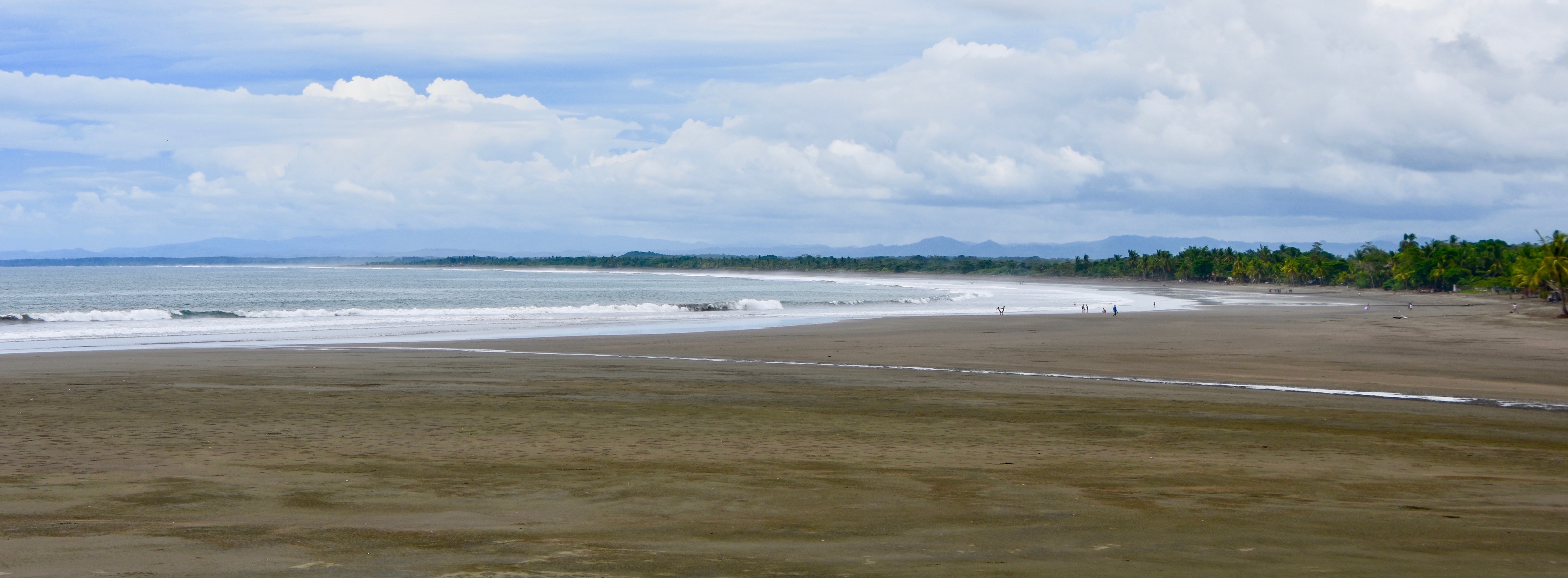
There still time for a beer before the bus leaves so we stop into a hole in the wall bar where a tattooed bar tender gets our Imperials and then proceeds to talk to a bluish fish in a tiny goldfish bowl. It listens to her when she shows that it will rise to the surface or sink to the bottom on command. I kid you not.
Back on the bus, the countryside changes dramatically as we head up high into the forest and suddenly there are McMansions on every hillside and a variety of resorts running from simple hostels to true five star wallet breakers. This is definitely a side of Costa Rica we have not seen before.
La Mariposa Hotel
Our accommodations for the next two nights will be at the luxurious La Mariposa Hotel which has absolutely stunning views from the top floor balcony that overlooks the islands and beaches of Manuel Antonio far below which remind me a bit of the Amalfi Coast. And being compared to the Amalfi Coast is never a bad thing. It was also the first hotel opened in Manuel Antonio after it became a national park in 1972 and so got the choice location.
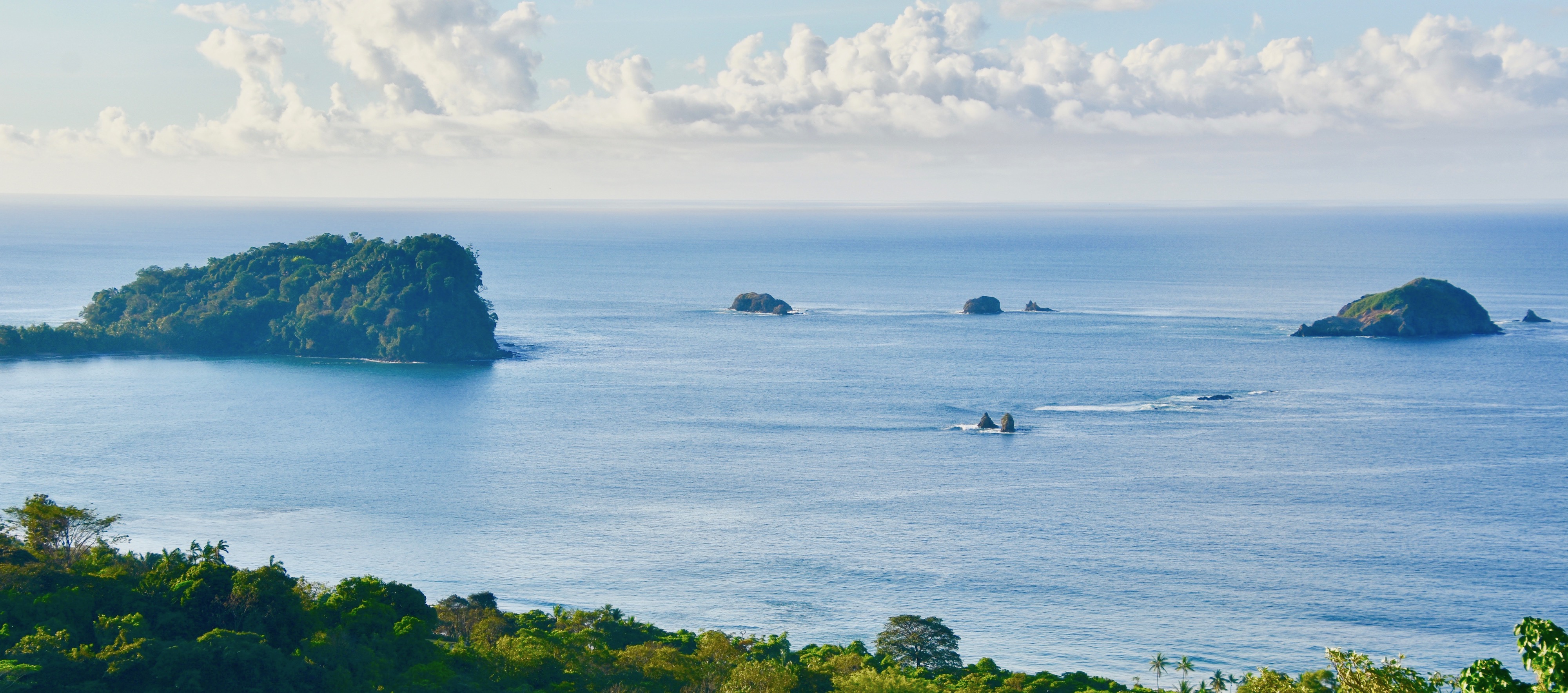
The rooms are ultra modern with large balconies. The only problem with ours was that the view was obscured by a bamboo stand. If you do stay here, insist on a room with the million dollar view; it won’t cost nearly that. With nothing else planned for the day but dinner, there’s time to take a dip in the infinity pool or have a drink at one of the two small pool bars. Aah, life is tough on these Adventures Abroad tours.
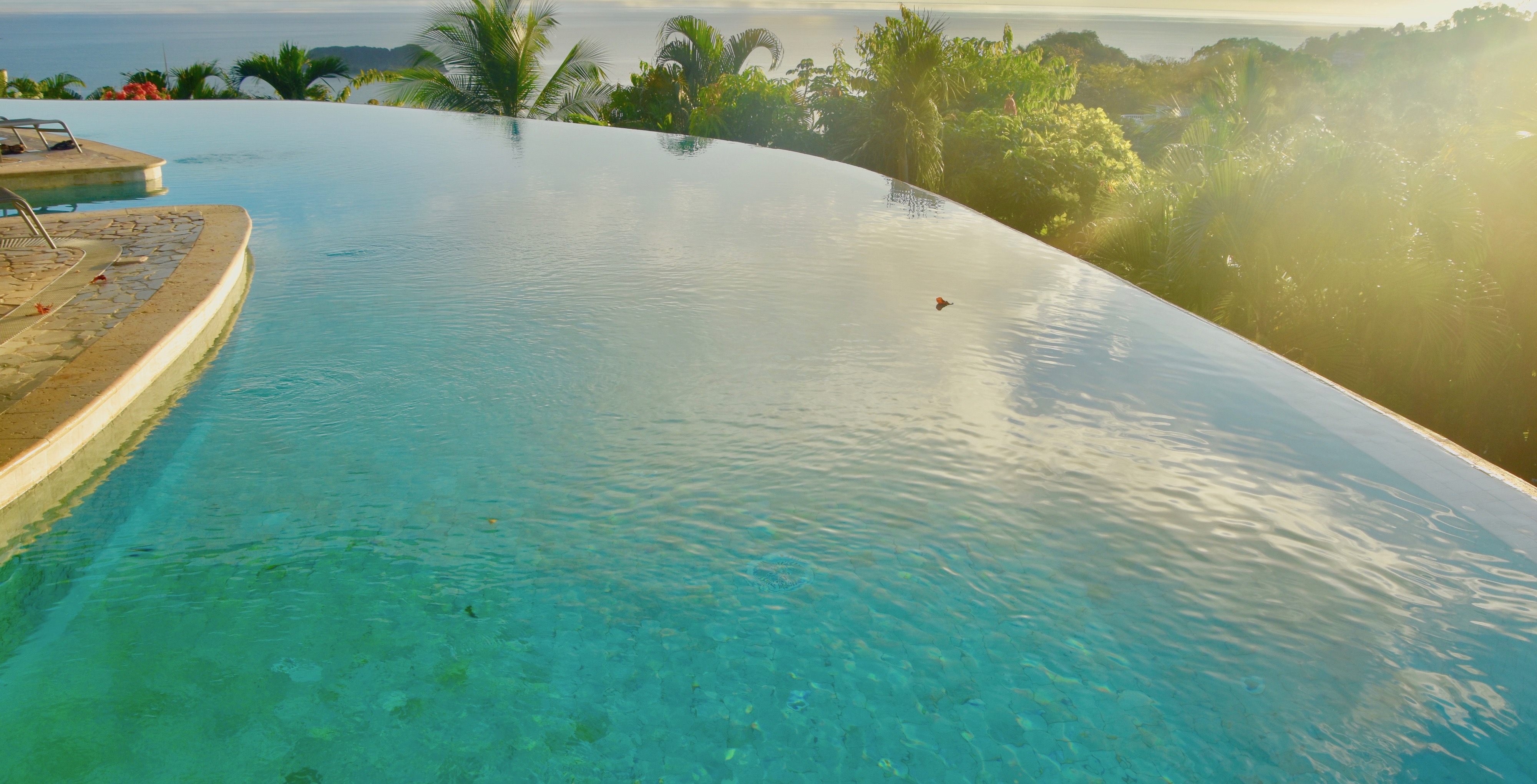
Seriously though, this was one of the best places we’ve ever stayed on an AA trip or any trip for that matter. Oh, and it’s listed as one of the 1000 Places to See Before You Die in Patricia Schultz’s runaway bucket list best seller.
Ronny’s Place
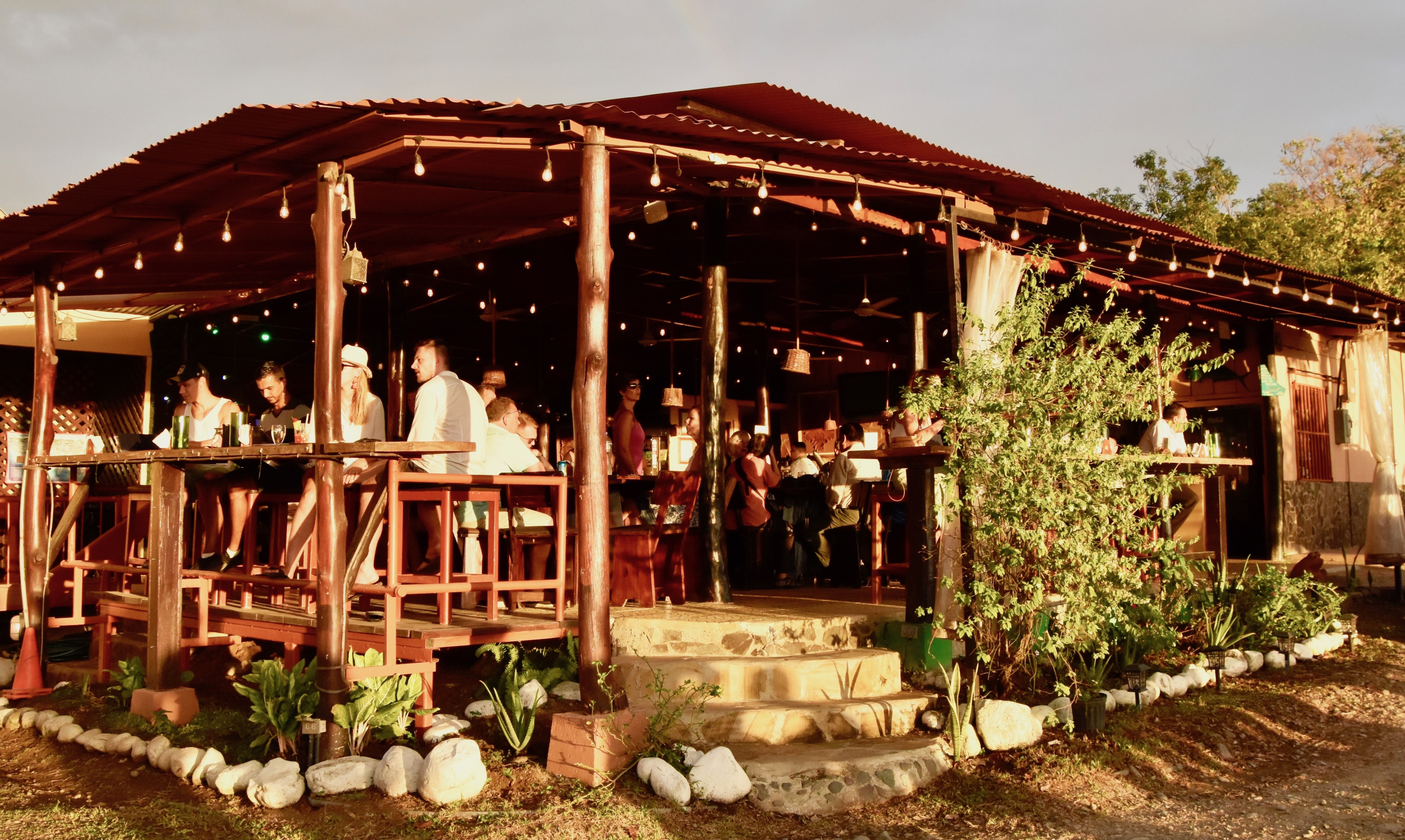
For dinner that evening we didn’t eat at any of the fancy places right in Manuel Antonio or Quepos – I never did figure out where one stopped and the other started. Instead we took the bus down a tiny dirt lane not wide enough for two cars to pass, let alone a bus and arrived at Ronny’s Place high above the ocean and apparently famed for its sunsets. There were already a lot of people there just for that, all hoping to see the ever elusive ‘green flash’. One person in our group claimed she had seen it and I believed her, but tonight conditions were not right and we got about a C+ setting.

What was well above C+ was the food, especially the seafood. This is my ceviche, a dish I could eat at least 200 days a year.
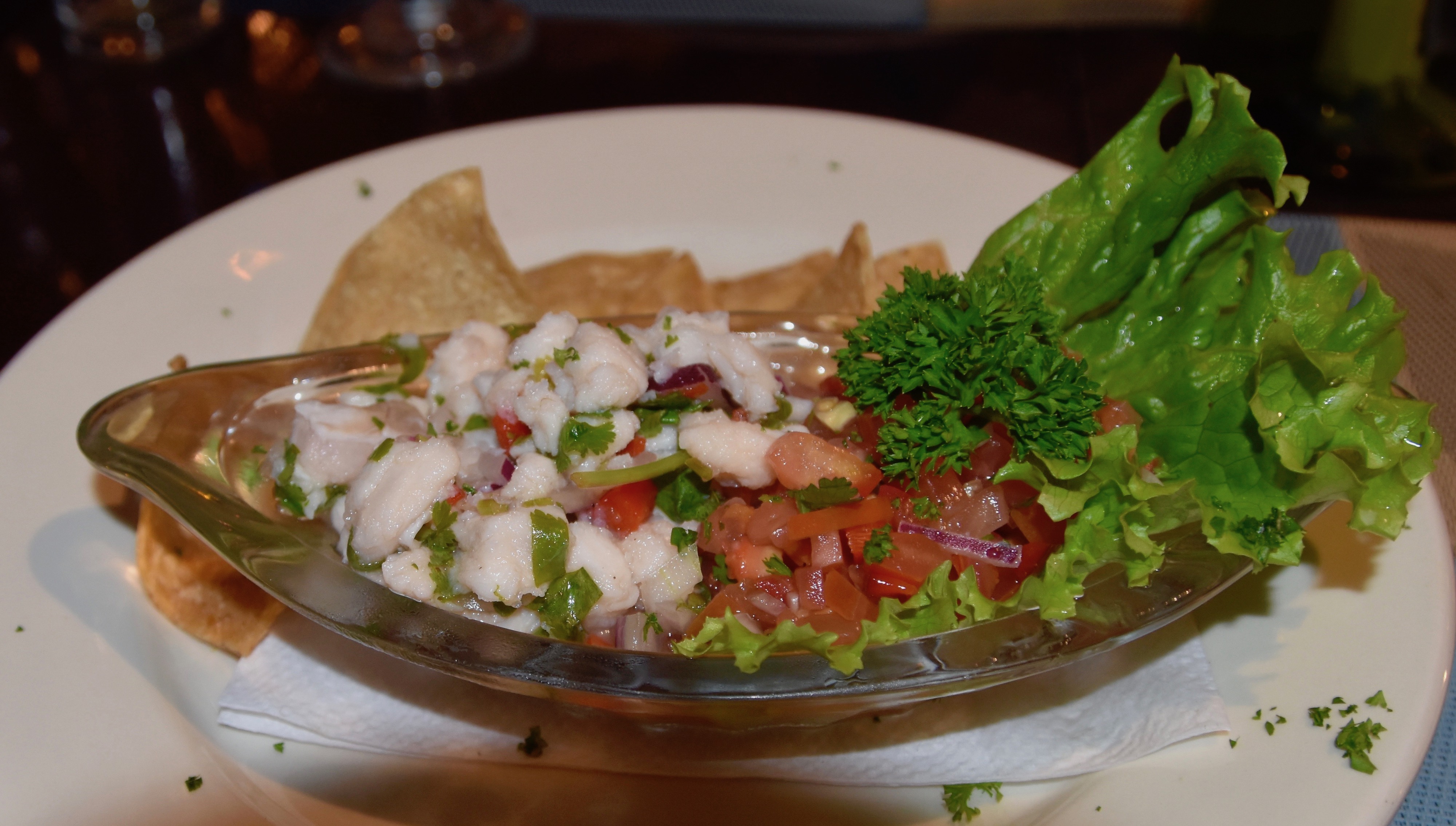
This was described as red snapper, the special of the day. Never sure what you’ll really get when you order red snapper, but whatever this fish it it was delicious and very photogenic too.
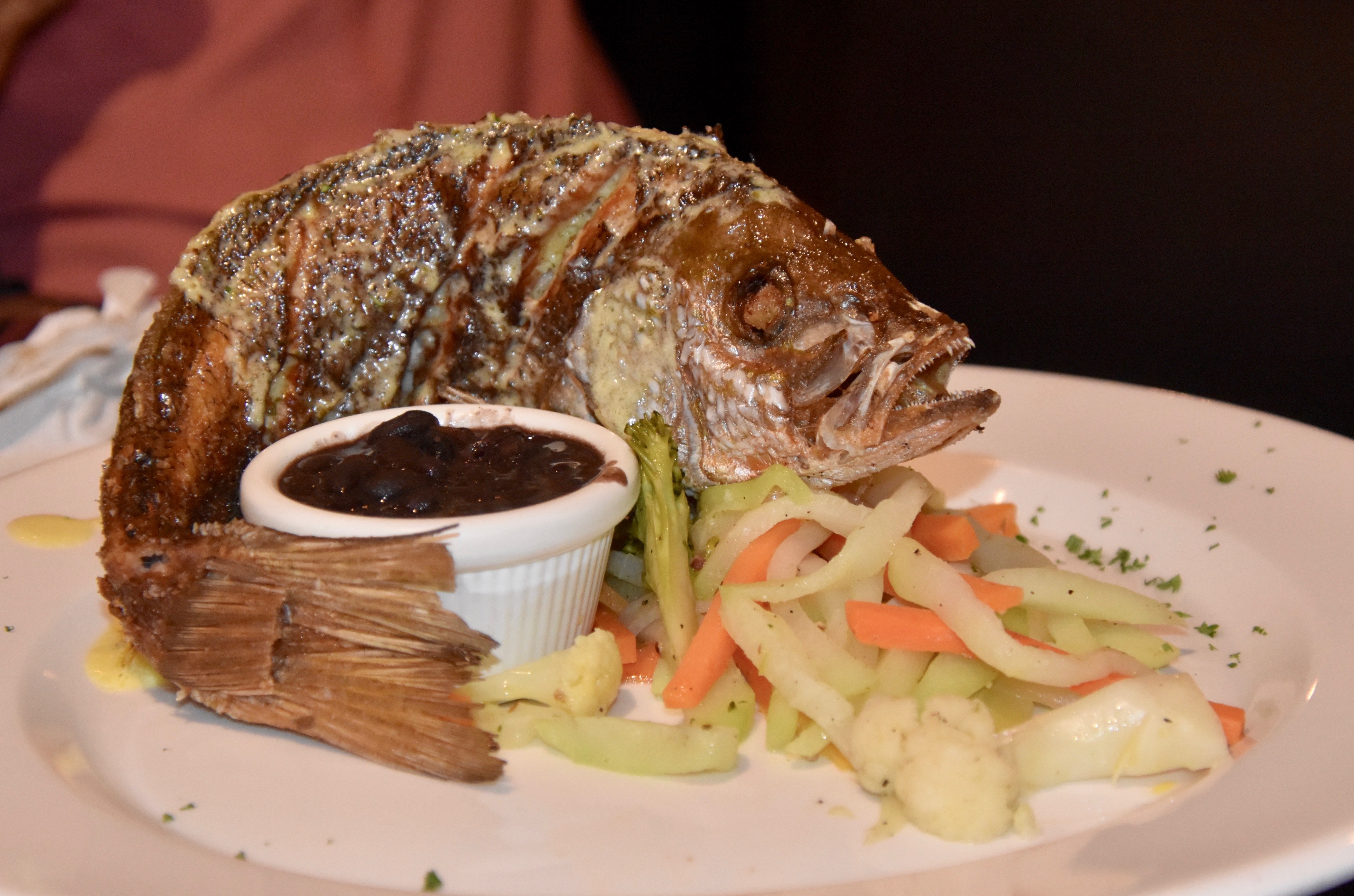
So even though this was billed as a travel day on the itinerary, it was pretty damn full. Tomorrow Manuel Antonio.
History of Manuel Antonio National Park
Nobody knows who Manuel Antonio was or even if he was a real person, so why the park bears this name is unknown, but paraphrasing Shakespeare – a park by any other name would be as sweet, so it’s not important. Agriculture and forestry had so devastated the natural biota of Pacific coast of Costa Rica that by the 1970’s only two patches remained of which Manuel Antonio was one. The residents of Quepos, whether in boom times or busts, liked to hike in the nearby mountain forests and especially to walk, swim and play on the four beaches just west of the town. Following the example of many other places around the world, including my native province of Nova Scotia, foreign interests found the beautiful land and seascape to their liking as well and bought it, the last landowner being Arthur Bergeron of France. Stupidly, he erected fences to stop the locals doing what they had been doing for centuries and the public outcry ended with the expropriation of Bergeron’s interests and the creation of the park in 1972.
Bergeron’s loss was the world’s gain as Manuel Antonio regularly makes the lists of best national parks in the world. It has become so popular that Costa Rica has had to limit the number of daily visitors. What that number is depends on what website you visit. I have seen figures from as low as 600 to as high as 1600. Fortunately for our group Victor has bought tickets in Quepos the day before and we won’t have to go through the lineups that regularly occur when the park opens each day at 7:00 AM. We also don’t have to run the gauntlet of scam artists claiming to be official guides or ticket sellers who plague the entrance. Why the government of a country as allegedly progressive as Costa Rica allows these guys to operate in broad daylight is ridiculous.
With rant #2 of this post disposed of, let’s visit the park.
Visiting Manuel Antonio
It’s a short drive from Le Mariposa to the bus parking lot near the entrance to Manuel Antonio after which we follow Victor through a not obvious gravel entry lane to the actual park entrance. Here is where he points out and tells us to ignore the scam artists and gives us our tickets. Manuel Antonio is very strict about preventing idiots from feeding the wild creatures of the park, so they do a cursory search of backpacks for elicit items like nuts, chips and anything else that will turn a perfectly normal wild animals into crazed junk food addicts that will sell their souls (if they have one) for a friggin’ peanut.
This is a map of the park. It is small enough that you could walk the entire trail system in one day, but most people, including our group will follow the tan coloured trail from the entrance to where it ends at the restaurant and gift shop. This is where most of the wildlife spotting is done. After that, the most logical route is to return via Espadilla Sur Beach to the boardwalk marked in blue and back to the entrance. This route also offers the option of doing the circular Punta Catedral trail around the tombolo that is connected to the mainland by a narrow isthmus with beaches on each side.
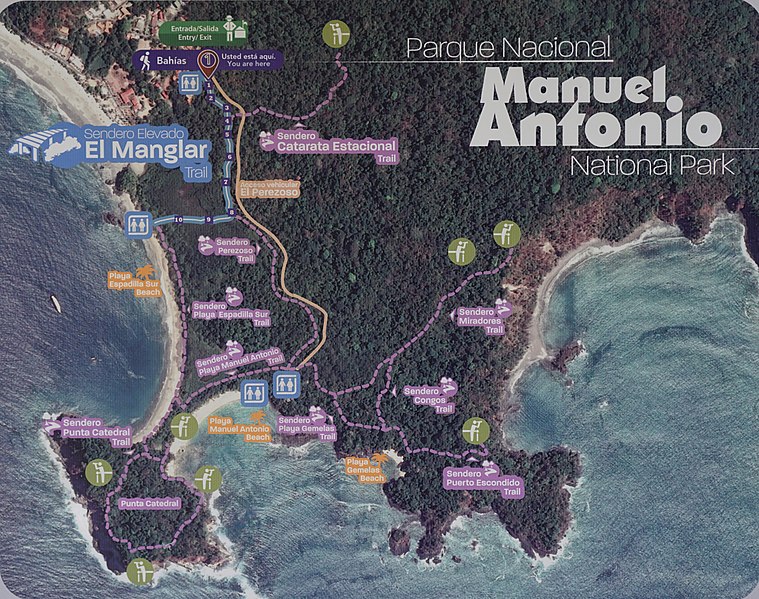
Victor has procured two guides, Daniel and Andre to assist us in spotting the wildlife. They have binoculars and spotting scopes and trust me, without a guide, you would miss 90% of what there is to see. One last caveat. Even with restricted numbers, Manuel Antonio is still going to seem overcrowded, especially when someone spots something interesting and a number of groups converge. But, hey, that’s the price of popularity. If you want solitude visit Costa Rica’s Cocos Island National Park some 550 kms. (341 miles) off the Pacific coast.
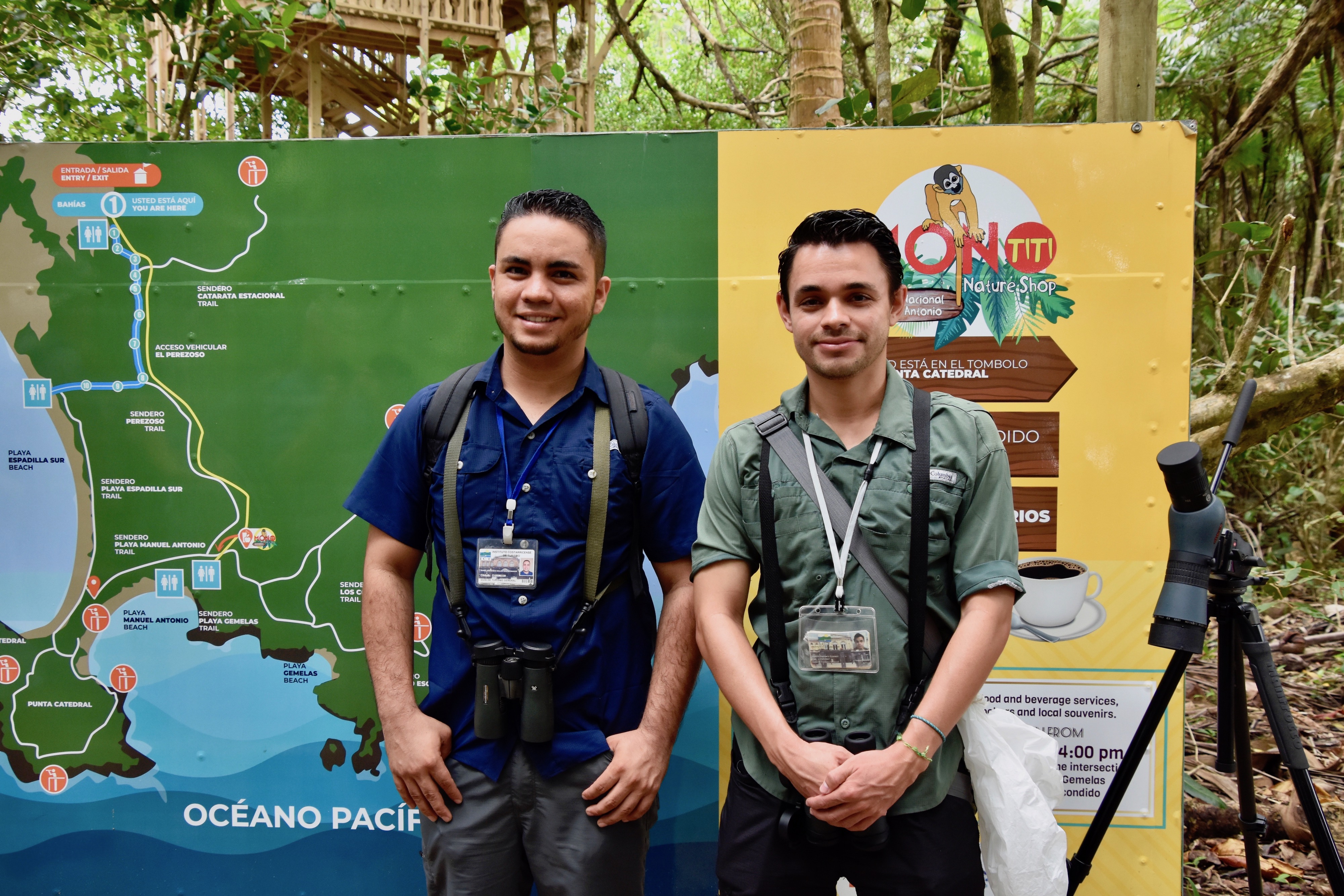
Ok, let’s get started. The main things you are going to see in Manuel Antonio are monkeys, sloths, lizards, birds and butterflies. You are not going to see jaguars, queztal birds or other exotic species that from the Costa Rican tourist literature you would think are as common as house flies. Still, it’s an interesting menagerie and well worth the walk.
I almost forgot. The weather forecast was for a 7% chance of rain so despite ominous looking skies I foolishly believed the weatherman and did not take rain gear or my waterproof camera. So of course the skies opened up the minute we started our guided walk, The result was that I did not get more than a few decent pictures.
We did see both three-toed and two-toed sloths as well as lots of white-faced capuchin monkeys, but I due to the lighting and the rain I got no useful photos of them. What was endlessly entertaining was watching the monkeys cross over the trail directly above us. In order to do so they had to make a leap of about six to eight feet from one tree to another and while the adults had no problem, the youngsters were apprehensive and you could see them weighing their chances. A fall directly down could be fatal. Eventually, all but one made the attempt and succeeded. The smallest one that wouldn’t jump was retrieved by his mother who leapt over with him holding on. It was interesting to see that, just like humans, monkeys are not necessarily born with the ability to do certain things, but must learn how to do them using the tools that Mother Nature provided them with.
This is a male common basilisk, a lizard famed for its ability to ran so fast over water that they don’t sink. Hence the nickname ‘Jesus lizard’.
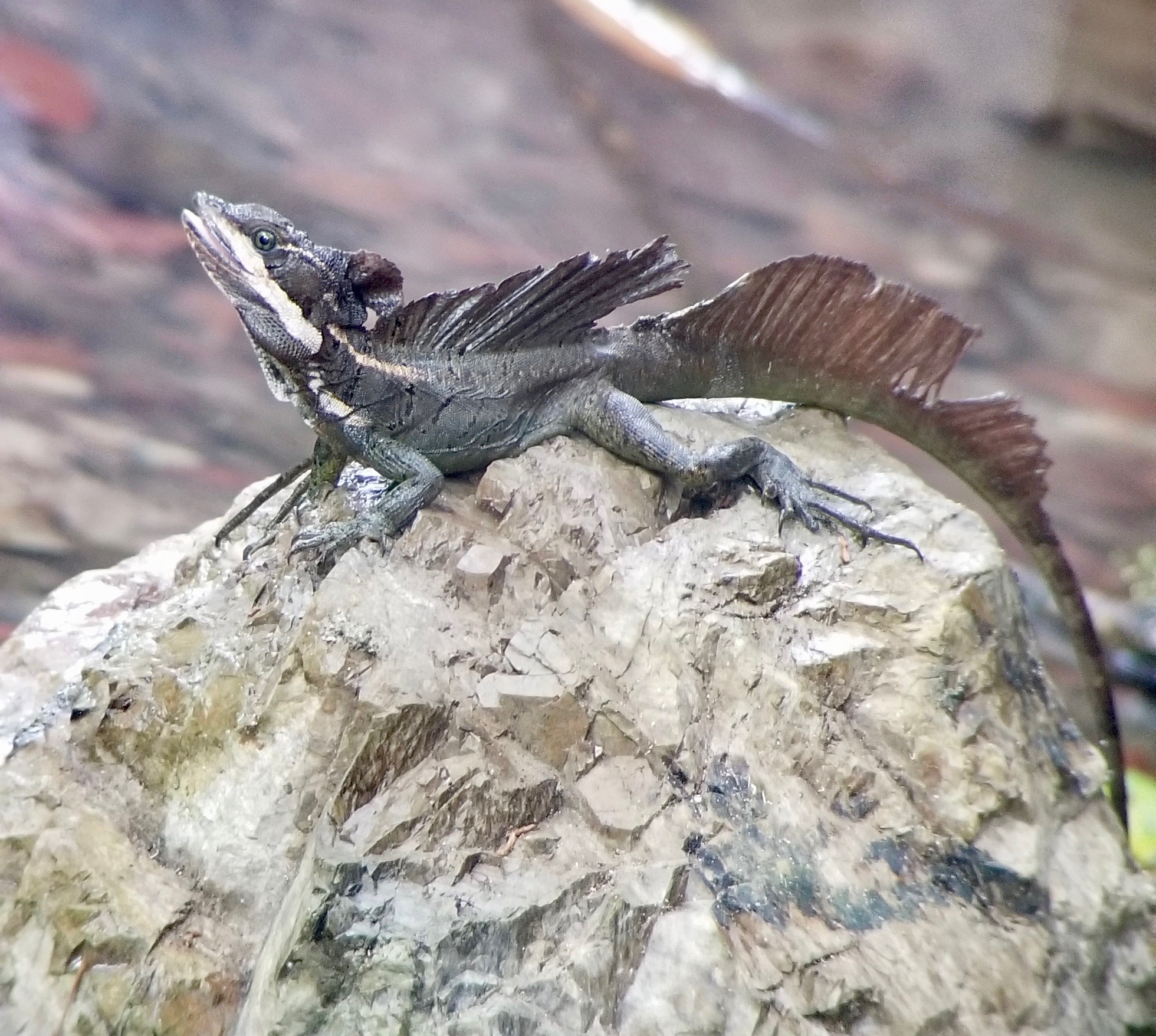
Another species of basilisk is the brown which we observed on several occasions.
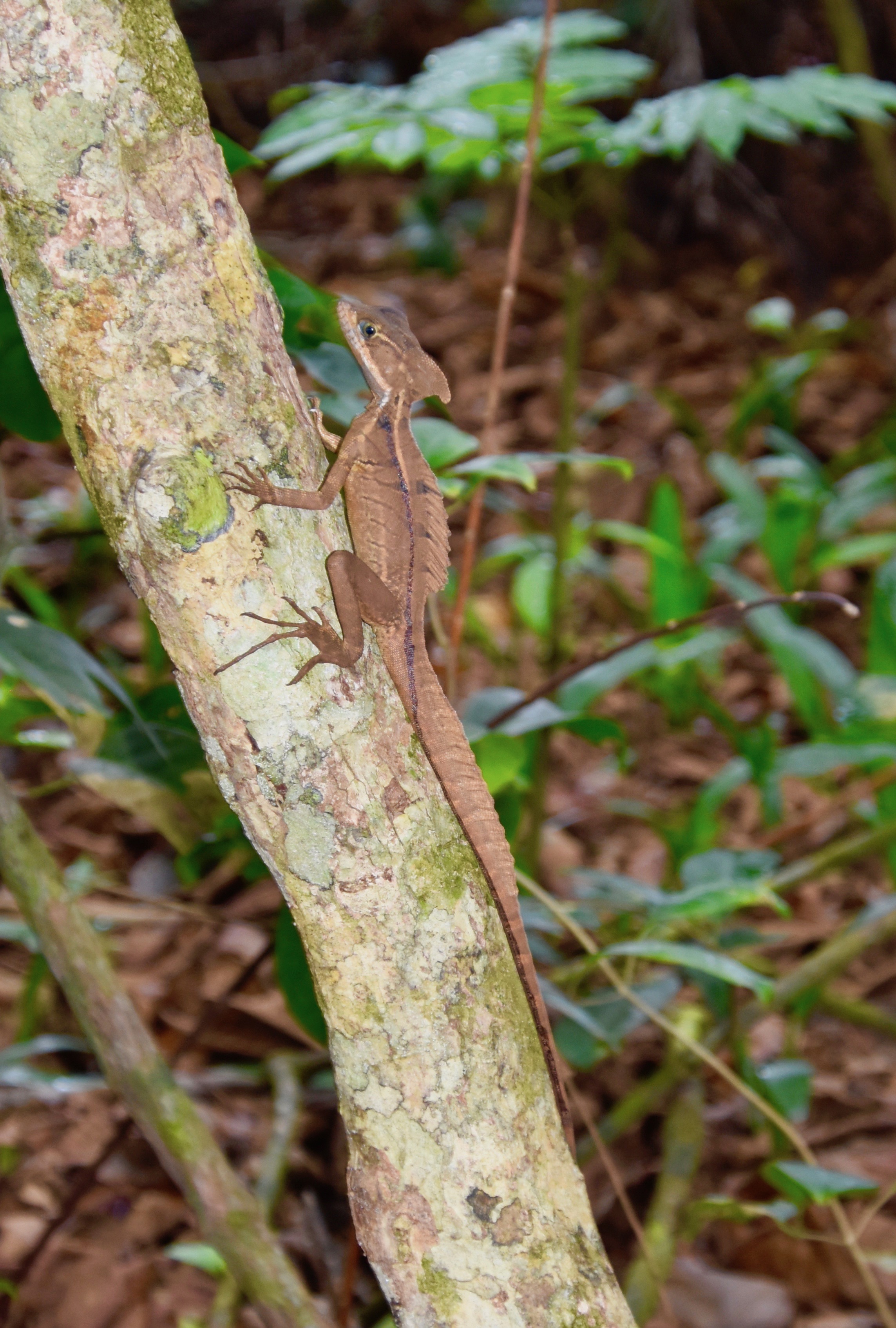
There are also lots of land crabs in Manuel Antonio, all very brightly coloured.
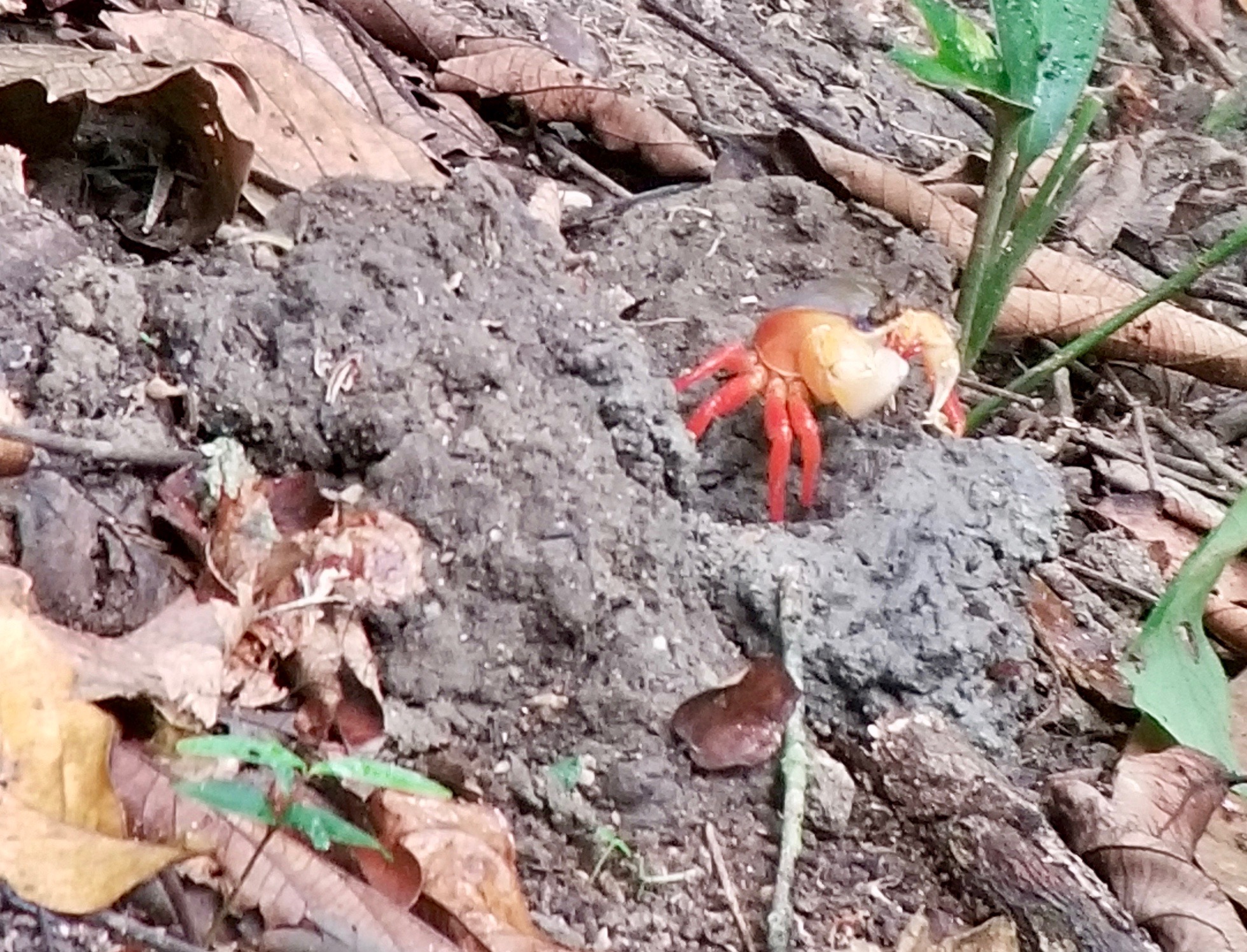
The most creepy thing we saw was this butterfly or moth that was perfectly still on this branch and perfectly dead. It has been attacked by a species of zombie fungus that literally takes over the insect’s brain and turns it into a zombie while the fungus slowly grows and grows until at last there nothing but a husk. It would make a good subject for a Far Side cartoon. I can just see the adult butterfly reading a bedtime story to a bunch of enrapt caterpillars about one who wouldn’t eat his milkweed and got turned into a zombie.
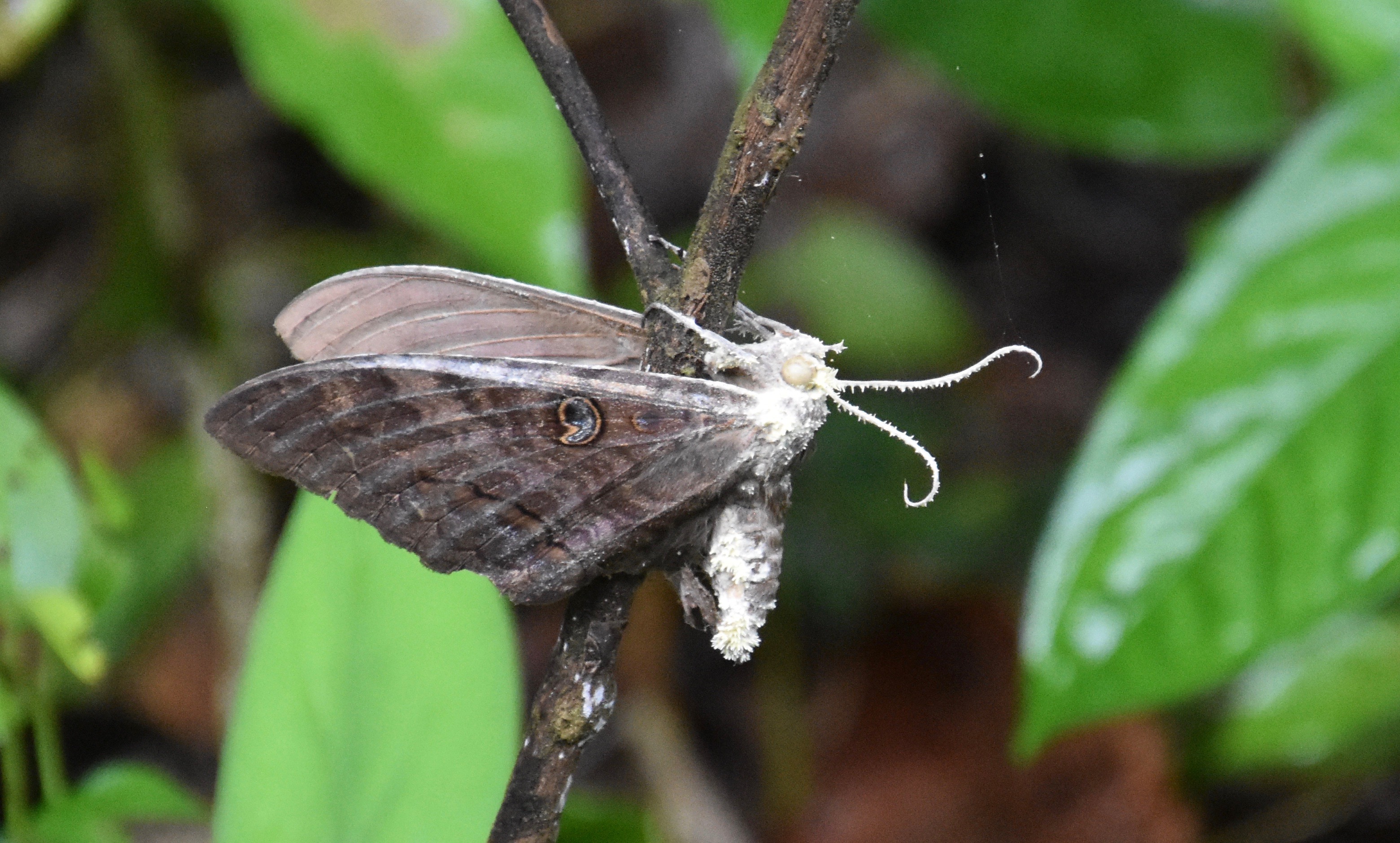
After the wildlife walk the guides left us at the beach, but not before taking a group shot, a rarity for Adventures Abroad. That’s your humble servant and Victor on top.
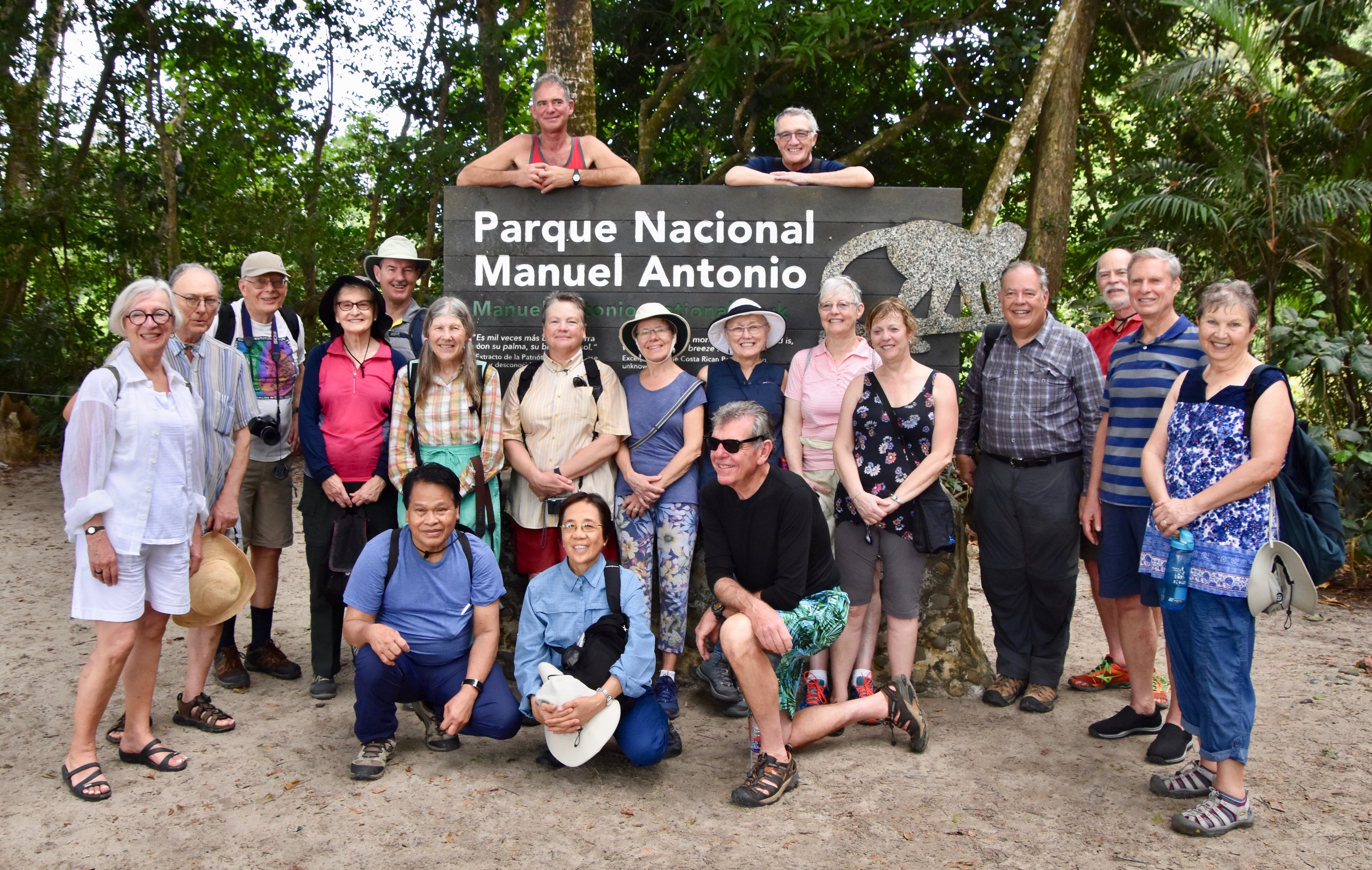
Victor then explained our various options before returning to the bus.
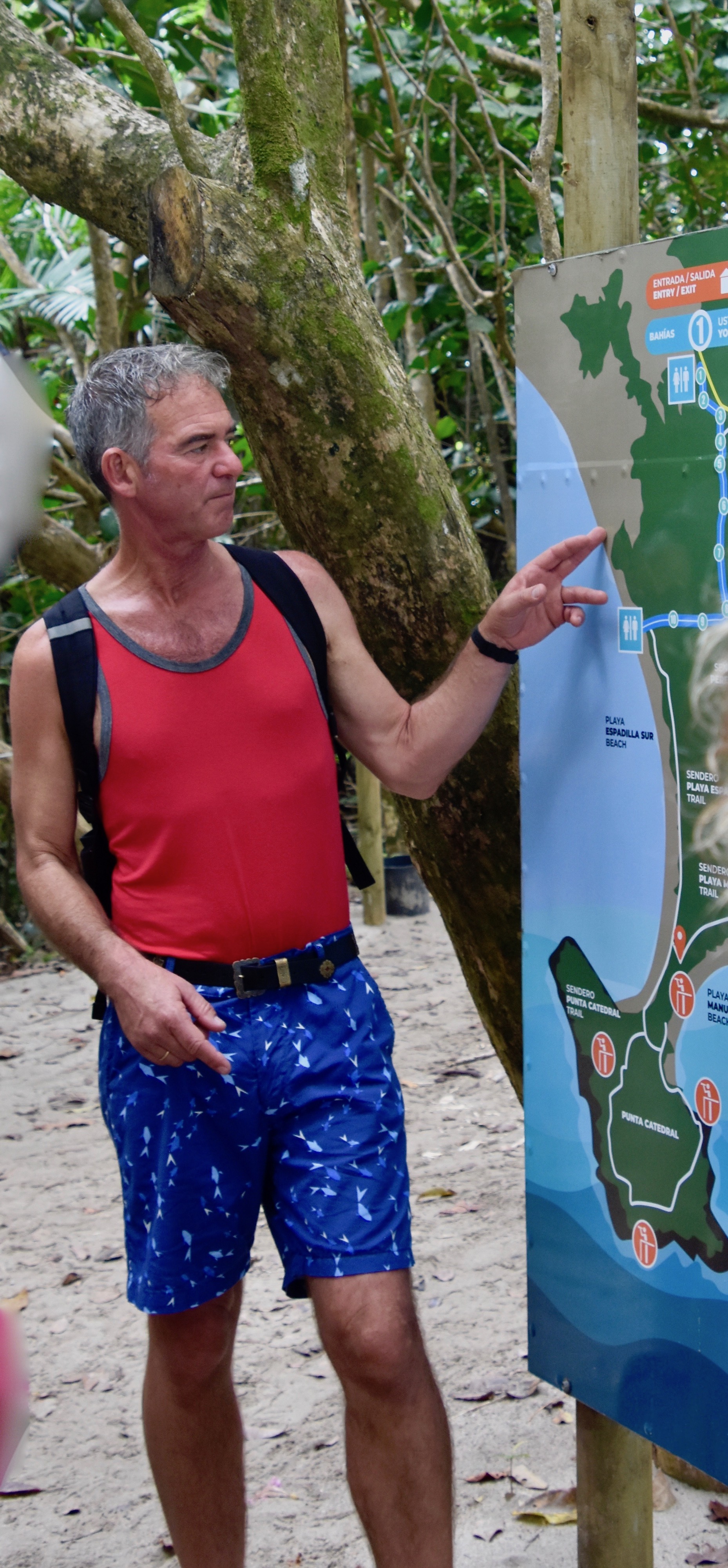
About half the group opted for the hike around the tombolo on the Punta Catedral trail which has several lookouts with views of the offshore islands.
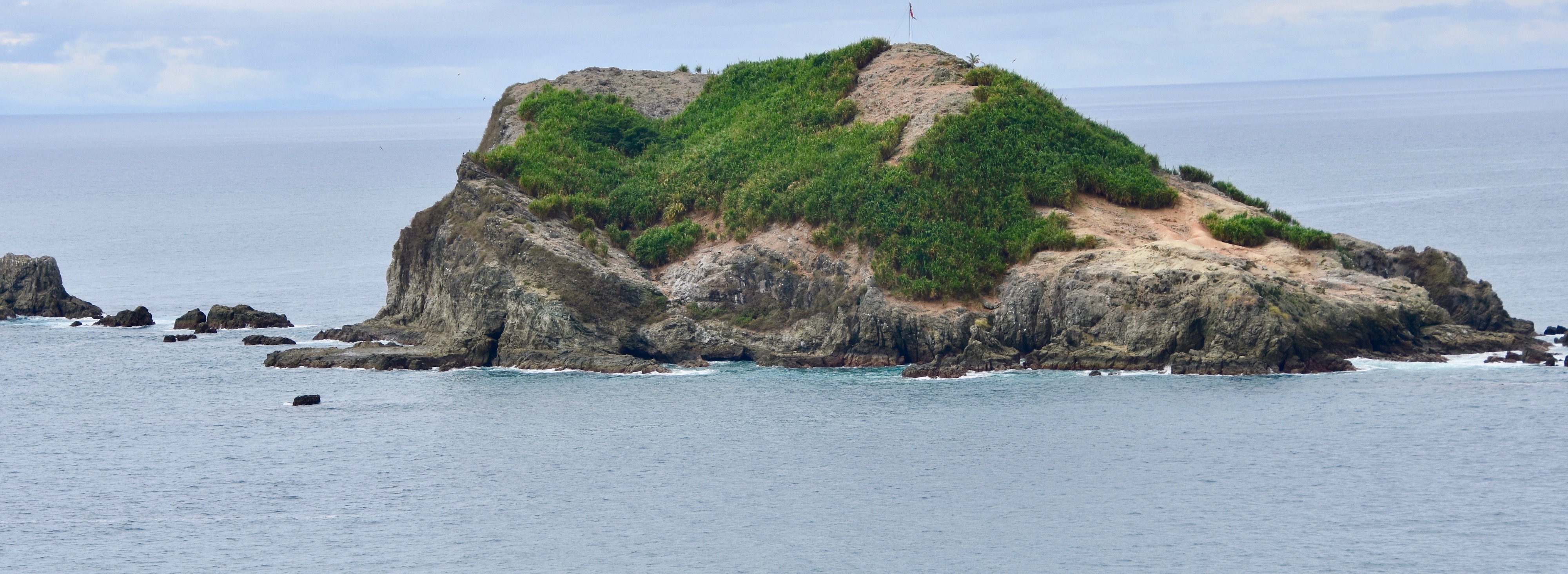
If you look closely in the lower right hand corner of this photo you can see stand up paddlers heading towards another island. It’s just one of the many things you can do at Manuel Antonio and on a calm day like this would be fun.
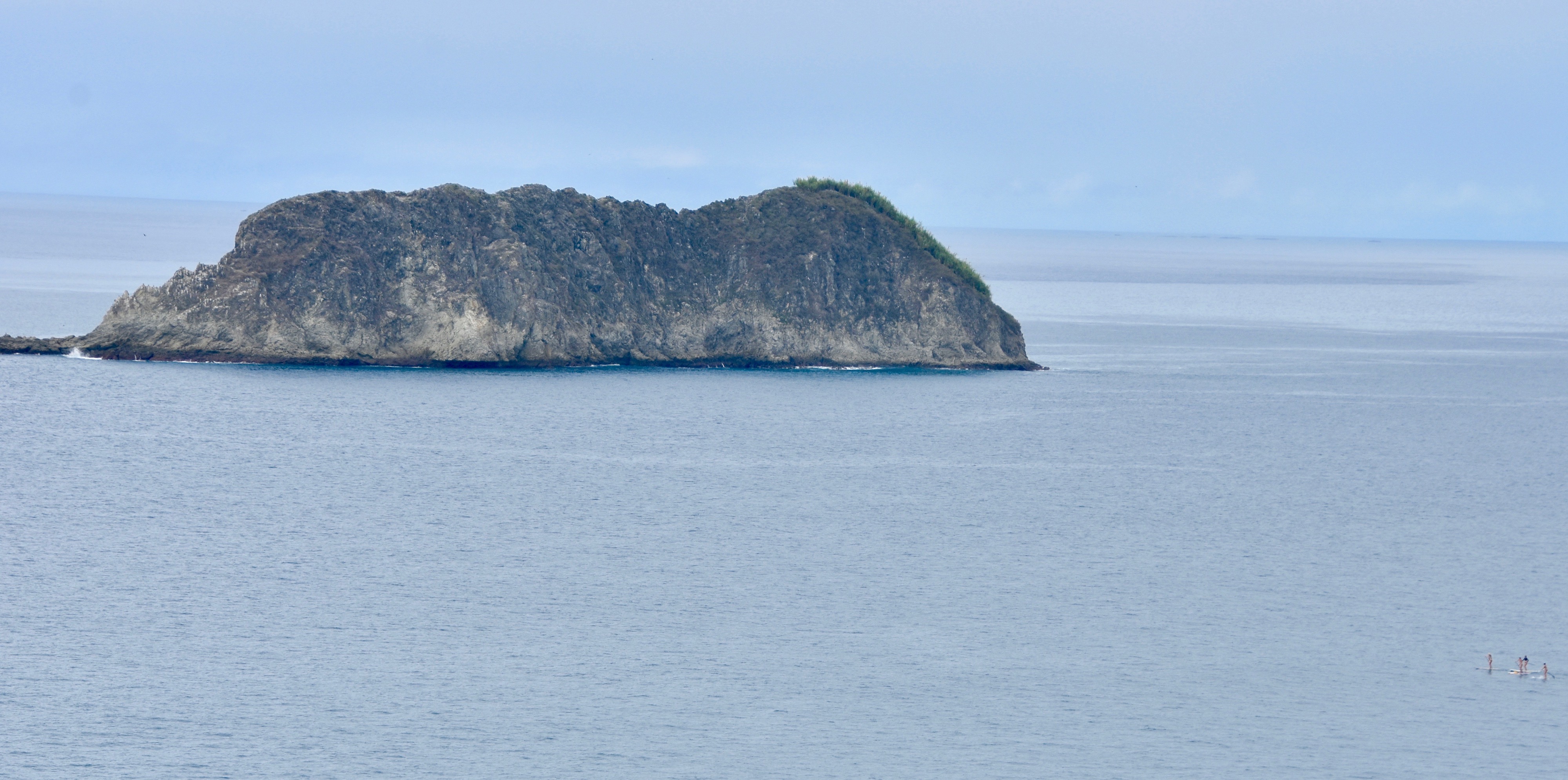
From here we made our way to Manuel Antonio beach which is truly beautiful.
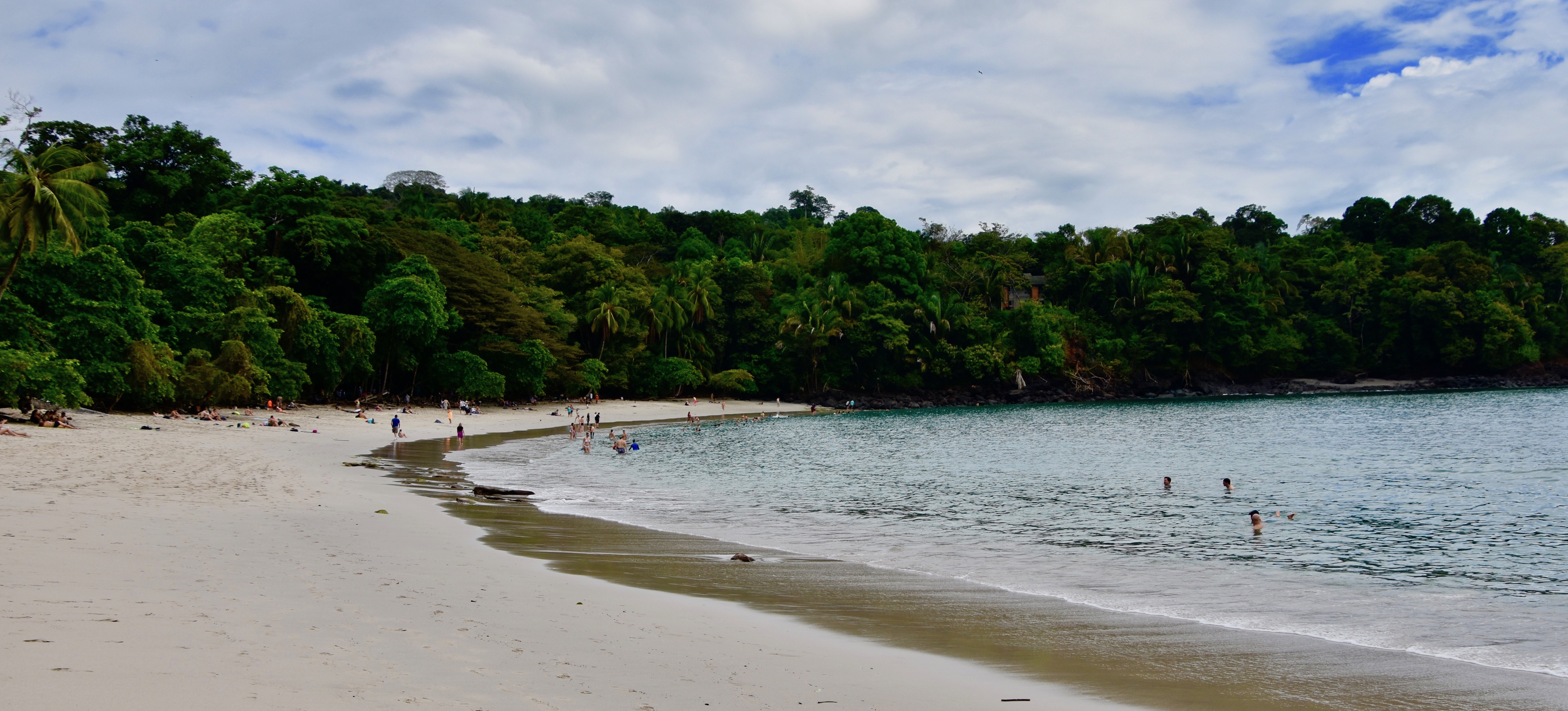
Victor had warned us about rip currents with such conviction that none of us decided to risk going in.
On the other side of the tombolo and the way back to the entrance is equally beautiful Espadilla Sur Beach which you can see in this video I shot.
The prefect ending to this morning in the rain forest and at the beach was a cold Imperial at the open air restaurant right beside the bus parking lot.
Next we head inland and upward to the cloud forest of Monteverde. Hope you’ll come along.

